Sarah trigg
Subject Name : Sarah Trigg (b ca 1826 – d ?)
Researcher : Mike Brock
Three-times married Sarah Trigg was found ‘not guilty’ at a double-murder trial following the deaths of her first husband and one of her sons, both from arsenic poisoning, despite seemingly overwhelming evidence against her.
She was born as Sarah Crawley in Watford, Hertfordshire in about 1826, the daughter of James, a labourer, and Diana Crawley, and baptised on 29th October that year at Watford’s St Mary’s Church.
The 1841 Census showed Sarah, noted as age 10 but probably 15, living in the hamlet of Oxhey on the outskirts of Watford. With her were father James, a 50-year-old agricultural labourer, mother Diana, 45, and siblings William (20), James (10), Joseph (9) and Caroline (7).
Sarah married bachelor John Newton, a labourer, on 15th September 1846 in Bushey Parish Church and they soon settled in Rowley Green, Shenley, Hertfordshire, just a short distance east of Oxhey, near to Barnet. The 1851 Census showed Sarah, age 24, with husband John, a coke and coal dealer aged 25 born in Ruislip, Middlesex, and their sons William, 4, and James, 2.
Everything sounds perfectly normal so far, but this would prove to be far from the truth when three years later, on 27th May 1854, John passed away at home aged 27. According to his death certificate, John had been suffering from a ‘chronic disease of the brain’ for a ‘long duration’. He was buried in Shenley.
Suspicious Deaths of Husband and Son
Just a few weeks later on 21st July, Sarah and John’s eldest son William also died, aged 7. There were immediate suspicions about the cause of William’s death as the previous day, he had seemingly swallowed a ‘blueish powder’. 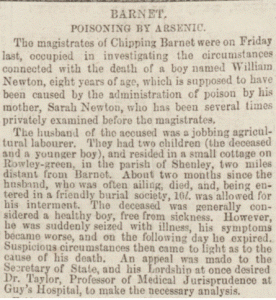 Sarah was arrested and sent to Hertford Gaol on 24th July awaiting trial for ‘having administered poison to her child’. William’s death certificate, written on 30th September following a coroner’s inquest, starkly said that the seven-year-old had been ‘wilfully murdered’.
Sarah was arrested and sent to Hertford Gaol on 24th July awaiting trial for ‘having administered poison to her child’. William’s death certificate, written on 30th September following a coroner’s inquest, starkly said that the seven-year-old had been ‘wilfully murdered’.
At that inquest in August 1854, Sarah said that her son William, on the day before he died, had ‘picked up something going to school in the morning in a paper, and it hung about his mouth like flour’. She said that William had been sent home sick by the schoolmistress, although the schoolmistress denied that she had done so. William was vomiting at home that evening, so following the advice of a policeman, Sarah called for a doctor to attend to her son. The following day, Sarah took a sample of William’s vomit to the doctor as requested and to collect more medicine, but William became worse and died that evening. The sample Sarah had brought was taken for analysis and found to contain arsenic. When asked at the inquest if she had anything to say, Sarah replied ‘I am innocent of the charge’.
With William’s death following on so soon after that of his father John, it was ordered that John’s body should be disinterred. Forensic tests showed it was clear that arsenic was present throughout John’s body as well.
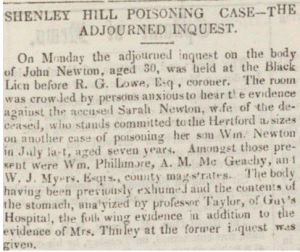 On 20th November 1854, an inquest into John’s death was held at Shenley’s Black Lion inn. John’s doctor, who had written the original death certificate, said that he had been treating John for a long time for a brain condition and assumed that this had been the cause of death, but that he now believed John died ‘from the effects of poisoning’.
On 20th November 1854, an inquest into John’s death was held at Shenley’s Black Lion inn. John’s doctor, who had written the original death certificate, said that he had been treating John for a long time for a brain condition and assumed that this had been the cause of death, but that he now believed John died ‘from the effects of poisoning’.
Several more people, including Sarah’s mother-in-law, gave telling evidence at the inquest.
William Kirby (referred to in some newspapers as Thirley), with whom the Newtons had been lodging, said he had heard John and Sarah quarrelling several times and in the week of John’s death, Sarah had commented ‘John has got a bad pain in his side, and that is one good job’.
A chemist testified that he had twice sold rat poison to Sarah, the second time shortly before the death of her son William.
At the end of the inquest, the jury found that Sarah had ‘wilfully murdered’ her husband. The final verdicts would be made on both cases at the Hertford Assizes on 1-2 March 1855.
Trials for Murder
The first case, heard in Hertford on 1st March, was that of Sarah’s son William, with John’s case the following day.
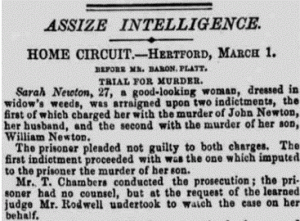 Described as ‘a good-looking woman, dressed in widow’s weeds’, 27-year-old Sarah pleaded not guilty to both charges. Although Sarah had no counsel, the judge asked a Mr Rodwell to act on her behalf.
Described as ‘a good-looking woman, dressed in widow’s weeds’, 27-year-old Sarah pleaded not guilty to both charges. Although Sarah had no counsel, the judge asked a Mr Rodwell to act on her behalf.
Detailed evidence for both allegations against Sarah was heard again over the two days.
Summing up William’s case, Mr Rodwell addressed the jury, saying that William had picked up the poison from the road and eaten it, and that Sarah had no possible motive for killing a seven-year-old. The fact that she had given the doctor a sample of what William had vomited shortly before his death meant that she would not have done this if she had administered the poison to William. Following Mr Rodwell’s ‘able, argumentative and eloquent address’, the jury found Sarah ‘not guilty’ of murdering her son.
The next day the jury heard evidence for the case of Sarah’s husband John. The same witnesses from the inquest testified. Mary Kirby, the wife of the owner of cottage where the Newtons had been living, claimed to have seen Sarah giving John a dark powder ‘a powder…of a rather dark colour’ which Sarah had said ‘would stop his retching if anything would’. Mary commented that the Newtons quarrelled regularly. Shortly before John’s death she had heard Sarah saying to John that she wanted a new gown – ‘a black one for you’.
In his address to the jury after the case had been heard, Mr Rodwell argued that there were several areas where evidence was lacking. For example, he questioned the evidence of Mary Kirby, who said she had seen Sarah giving John a powder which was alleged to be the poison. Mr Rodwell argued that why would Sarah have given John the poison in someone’s presence when ‘she had ample opportunity to give it to her husband in secret?’. Once again, and despite not one witness speaking in defence of Sarah, his arguments seemingly convinced the jury. Sarah was found ‘not guilty’ of murdering her husband.
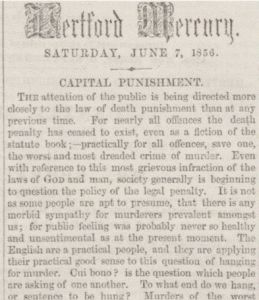 What could be the reason for these verdicts being returned in the face of so much apparently contrary evidence?
What could be the reason for these verdicts being returned in the face of so much apparently contrary evidence?
An article published in the Hertfordshire Mercury in June 1856 gives a clue. A Hertford Council meeting that 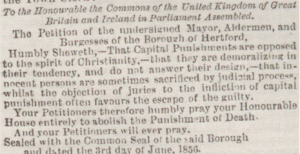 month had discussed in great detail the question of the death penalty, finally agreeing to present a petition to the House of Commons for its abolishment.
month had discussed in great detail the question of the death penalty, finally agreeing to present a petition to the House of Commons for its abolishment.
Sarah, had she been found guilty, would have almost certainly have faced that prospect. A
Mr Pollard, influential in pushing through the petition, used Sarah’s case as one example, saying 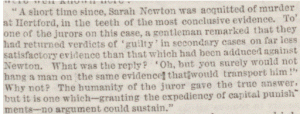 that while the death penalty existed, it prevented jurors from finding people guilty. The Hertford Assizes had a long record of leniency in murder trials, as no executions had taken place in Hertford since 1839. By being found not guilty, not only had Sarah avoided the death penalty, but also any punishment whatsoever.
that while the death penalty existed, it prevented jurors from finding people guilty. The Hertford Assizes had a long record of leniency in murder trials, as no executions had taken place in Hertford since 1839. By being found not guilty, not only had Sarah avoided the death penalty, but also any punishment whatsoever.
Sarah was of course now free to continue her life with her remaining son 5-year-old James.
Sarah moves on
Whether Sarah and James remained in Rowley Green is not known, but on 5th July 1857, Sarah, age 30, married 40-year-old Guildford-born widower Robert Burden, a labourer, in Hillingdon, Middlesex. He also had a son, Robert, the same age as James.
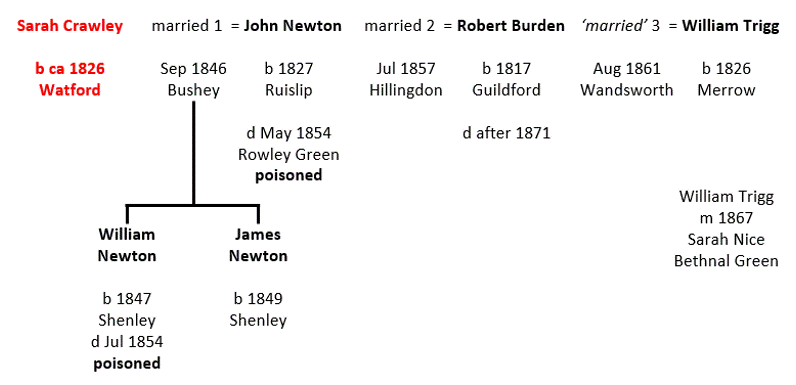 Neither Sarah nor her son James have been traced on the 1861 Census, but she appeared to have split from husband Robert, as he and his son were living with relatives in Norwood, Middlesex.
Neither Sarah nor her son James have been traced on the 1861 Census, but she appeared to have split from husband Robert, as he and his son were living with relatives in Norwood, Middlesex.
Just a few months later, Sarah married bachelor William Trigg on 18th August 1861 in St Anne’s Church, Wandsworth, Surrey. The marriage certificate stated she was Sarah Burden, a widow, something which was certainly not true as husband Robert has been traced on later Censuses.
William Trigg was born in Merrow, Surrey in about 1826, so Sarah and himself were both about 35 years old. Much of William’s family, including his parents Thomas and Hannah Trigg, still lived in Merrow, and at some stage after their ‘marriage’, William and Sarah moved there to live close to his parents *.
Life proved not to be easy in Merrow and problems soon arose. The West Surrey Times reported that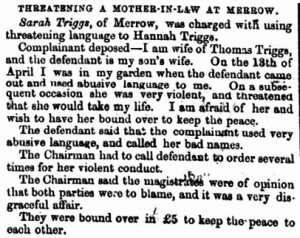 Sarah was summoned to the County Bench for using ‘abusive language’ to her mother-in-law Hannah on 13th April 1864. Hannah stated that Sarah, on a subsequent occasion, ‘was very violent, and threatened that she would take my life’. In her defence, Sarah said that Hannah ‘had called her bad names’ but the Chairman of the County Bench had to several times call Sarah to order for her violent conduct in court. The magistrates decided that both Sarah and Hannah should be bound over for £5 for what the Chairman called a ‘disgraceful affair’.
Sarah was summoned to the County Bench for using ‘abusive language’ to her mother-in-law Hannah on 13th April 1864. Hannah stated that Sarah, on a subsequent occasion, ‘was very violent, and threatened that she would take my life’. In her defence, Sarah said that Hannah ‘had called her bad names’ but the Chairman of the County Bench had to several times call Sarah to order for her violent conduct in court. The magistrates decided that both Sarah and Hannah should be bound over for £5 for what the Chairman called a ‘disgraceful affair’.
Around this time, the Guildford Union half-yearly accounts showed that Sarah’s husband William was receiving outdoor relief for ‘illness’ and that later in 1864, both Sarah and William went into the Guildford Union Workhouse. There are no admission records to show their circumstances, but the accounts book notes that between September 1864 and March/April 1865 they spent about four months in the Workhouse.
What exactly happened to Sarah next is not clear but what is known is that on 30th September 1867, her ‘husband’ William married Sarah Nice in Bethnal Green, London. The marriage certificate noted both William and Sarah Nice as being ‘widowed’ and ‘of full age’, living in Bethnal Green. However, William was most definitely not widowed, as Sarah, his first ‘wife’, was noted from 1868 as living, often for long periods of time, in the Workhouse. This was confirmed by the 1871 Census in April, which showed 42-year-old Sarah Trigg as an inmate of the Guildford Union Workhouse, a widowed (sic) laundress born in Watford, Hertfordshire.
That Census showed Sarah’s son, James Newton, an unmarried 22-year-old garden labourer, living in Merrow close to where his mother had been in 1864 when she had clashed with her ‘mother-in-law’ Hannah Trigg. Sarah’s former ‘husband’ William Trigg, a 44-year-old farm labourer, was living a short distance away in Bower’s Lane, Worplesdon with his second wife Sarah, who was born in Long Melford, Suffolk, and was 26 years his senior.
The Guildford Union half-yearly accounts records only exist up to late September 1871, with the last year showing Sarah as an inmate of the Guildford Union Workhouse for almost all of the previous 12 months. So why was Sarah in the workhouse? She was still only in her forties, and no record has been found of any disability or illness preventing her from working. The circumstances around her separations from Robert Burden and William Trigg will never be completely known, and the workhouse may have been her only option. Perhaps her past had caught up with her.
It is ten years before another record is traced for Sarah which shows her again as an inmate of the Guildford Union Workhouse, a widowed 44-year-old (probably 54) laundress from Watford. Without further records available, though, it is not possible to say whether Sarah had been living there throughout the previous ten years, but it seems likely. During that time, she had become a grandmother, her son James having married Elizabeth Ricketts in 1871 with the 1881 Census showing them with their four children living in Merrow Common.
Unfortunately, this Census is the last record traced for Sarah. Maybe she adopted a new name in an attempt to conceal her past but, at the moment, the fate of a woman involved in so much controversy in her life remains a mystery.
January 2024
* Maps of East and West Merrow in 1839 showing the Trigg home can be found on the Merrow Resident’s Association website
We’d love to hear from you if you are a relative of this family.
Please contact us by email: spikelives@charlotteville.co.uk
 Spike Lives is a Heritage project that chronicles the lives of inmates, staff and the Board of Guardians of the Guildford Union Workhouse at the time of the 1881 Census. The Spike Heritage Museum in Guildford offers guided tours which present a unique opportunity to discover what life was like in the Casual/Vagrant ward of a Workhouse. More information can be found here
Spike Lives is a Heritage project that chronicles the lives of inmates, staff and the Board of Guardians of the Guildford Union Workhouse at the time of the 1881 Census. The Spike Heritage Museum in Guildford offers guided tours which present a unique opportunity to discover what life was like in the Casual/Vagrant ward of a Workhouse. More information can be found here
Sources
Ancestry.co.uk
FindMyPast.co.uk / British Newspaper Archive
General Register Office GRO.gov.uk
HertsLive HertfordshireMercury.co.uk
Surrey History Centre, Woking Surreycc.gov.uk
For a full list of references click here.
